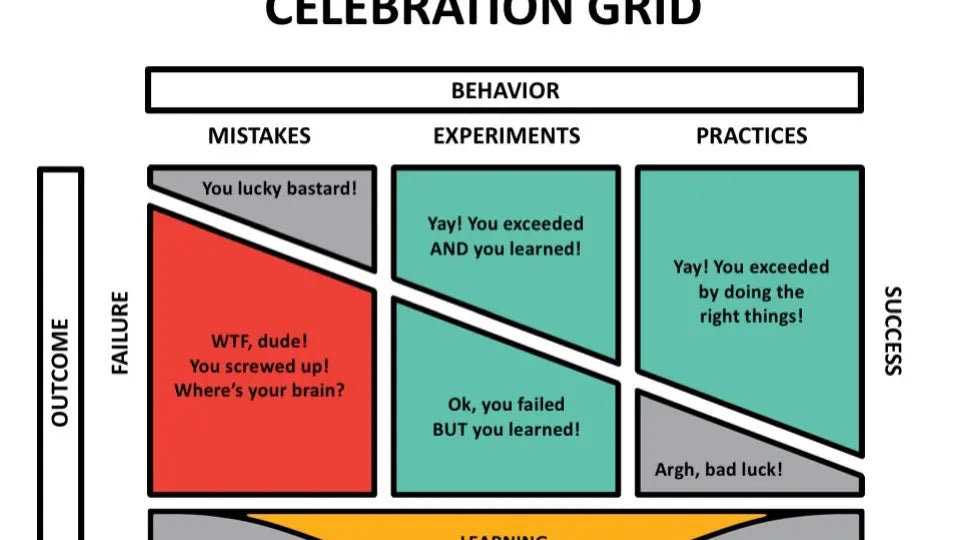
Management 3.0 Celebration Grid - Learning
Share
Management 3.0 Celebration Grid - Learning
Introduction
In today’s fast-paced environments, teams often focus solely on success, missing opportunities to reflect on experiments and failures that are equally valuable. The Management 3.0 Celebration Grid tool, encourages teams to embrace a growth mindset by analyzing both outcomes and processes. By shifting the focus from “what went wrong” to “what we learned,” this tool fosters innovation and continuous improvement.
Here’s a deeper look into how the Management 3.0 Celebration Grid works and my experience using it to help teams thrive.
What Is the Management 3.0 Celebration Grid?
The Management 3.0 Celebration Grid is a visual tool that categorizes actions and outcomes into three types of processes and three types of outcomes. It helps teams reflect on their work in a balanced way:
-
Processes:
- Practices: Established methods that are proven to work.
- Experiments: New methods or processes tested to solve a problem.
- Mistakes: Processes that didn’t achieve their intended results due to errors or unexpected issues.
-
Outcomes:
- Success: Desired results were achieved.
- Failure: Desired results were not achieved.
- Learning: Valuable insights gained regardless of the result.
This creates a 3x3 grid, with each action categorized based on the process (practice, experiment, mistake) and the outcome (success, failure, learning).
Why Use the Management 3.0 Celebration Grid?
The grid encourages teams to:
- Celebrate Experiments: Even if they fail, experiments often lead to learning that drives future success.
- De-stigmatize Failure: By treating failure as a natural part of innovation, the grid helps reduce fear and encourage risk-taking.
- Reflect Holistically: Teams analyze not just outcomes but the processes behind them, fostering a culture of accountability and improvement.
How to Use the Management 3.0 Celebration Grid
Step-by-Step Process:
1. Set the Stage:
- Choose a specific period to reflect on (e.g., a sprint, a project, or a quarter).
- Display the Celebration Grid on a board or digital tool where everyone can contribute.
2. Gather Examples:
- Ask team members to list significant actions or decisions from the chosen period.
- For each example, discuss whether it was a practice, experiment, or mistake and whether the outcome was a success, failure, or learning.
3. Categorize Actions:
- Place each action in the appropriate cell of the grid. For example:
- A tried-and-true approach that delivered results goes under “Practice/Success.”
- A new strategy that didn’t work as planned goes under “Experiment/Failure.”
- A mistake that revealed critical insights goes under “Mistake/Learning.”
4. Facilitate Reflection:
- Discuss patterns, key takeaways, and areas for improvement.
- Celebrate both successful outcomes and the learnings gained from failures and mistakes.
5. Plan Next Steps:
- Use insights from the grid to identify opportunities for future experiments or improvements.
My Experience Using the Management 3.0 Celebration Grid
I’ve used the Management 3.0 Celebration Grid extensively in retrospectives and coaching sessions with leaders and teams. Here are a few examples:
1. Encouraging Experimentation:
In one team, the Management 3.0 Celebration Grid helped shift their mindset from avoiding failure to embracing experimentation. For instance, we placed a failed A/B test under “Experiment/Failure” but celebrated the data it provided for the next iteration under “Experiment/Learning.”
Result: The team felt a little more comfortable testing bold ideas, leading to faster innovation.
2. De-Stigmatizing Mistakes:
During a retrospective, a team was hesitant to admit mistakes. Using the grid, I encouraged them to place a failed deployment under “Mistake/Learning” because it uncovered a gap in their release process.
Result: The team openly discussed the issue, implemented process changes, and felt safer discussing mistakes in the future.
3. Coaching Leaders to Use the Grid:
In coaching sessions, I helped leaders integrate the grid into their team meetings. By using the grid to categorize actions, they encouraged their teams to reflect on not just outcomes but also the processes leading to those outcomes.
Result: Leaders gained a more holistic view of their team’s performance and inspired a culture of growth and learning.
Why the Management 3.0 Celebration Grid Works
1. It Promotes Psychological Safety:
Teams feel safe discussing failures and mistakes when they are framed as learning opportunities.
2. It Builds Resilience:
By celebrating progress and learning, teams become more adaptable and open to change.
3. It Reinforces a Growth Mindset:
The grid highlights that success is not just about achieving outcomes but also about the journey and lessons along the way.
4. It Encourages Continuous Improvement:
The grid makes it easy to identify practices worth repeating and areas where experimentation can lead to growth.
Tips for Effective Use
1. Balance Positivity and Constructive Feedback: Celebrate successes but also dive into learnings from mistakes and failures.
2. Encourage Participation: Ensure all team members contribute to the reflection process.
3. Focus on Actionable Insights: Use discussions to drive specific, actionable steps for the next period.
4. Integrate with Other Tools: Combine the Management 3.0 Celebration Grid with tools like the Kanban board to track experiments and their results over time.
Takeaway
The Management 3.0 Celebration Grid is more than a reflection tool—it’s a mindset shift. By encouraging teams to celebrate all outcomes, including failures and learnings, it fosters a culture of innovation, psychological safety, and continuous improvement.
Have you tried using the Management 3.0 Celebration Grid in your retrospectives or team meetings? If not, it’s time to embrace the power of learning and growth!
Producer: Ricardo Fernandes
Linkedin
View all trainings
